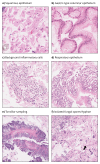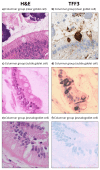Role of TFF3 as an adjunct in the diagnosis of Barrett's esophagus using a minimally invasive esophageal sampling device-The CytospongeTM
- PMID: 31814330
- PMCID: PMC7075710
- DOI: 10.1002/dc.24354
Role of TFF3 as an adjunct in the diagnosis of Barrett's esophagus using a minimally invasive esophageal sampling device-The CytospongeTM
Abstract
The incidence of esophageal carcinoma continues to increase whilst its prognosis remains poor. The most dramatic reduction in mortality is likely to follow early diagnosis of the preinvasive precursor lesion, Barrett's esophagus (BE), coupled with treatment of dysplastic lesions. The major risk factor for BE is gastroesophageal reflux disease, however this is highly prevalent and only a small proportion of individuals have BE, therefore an endoscopy-based screening strategy to detect BE is unfeasible. Minimally invasive esophageal sampling devices offer an alternative, cost-effective strategy which can be deployed within an at-risk population in a primary care setting to identify individuals with probable BE who can then be referred for endoscopic confirmation. The device that has currently progressed furthest in clinical trials is the CytospongeTM which collects cells from the gastric cardia, gastroesophageal junction and along the whole esophageal length. The cell sample is processed into a formalin-fixed paraffin-embedded block and sections assessed for the presence of intestinal metaplasia. TFF3 immunohistochemistry has consistently been shown to be a valuable adjunct that increases the accuracy of the CytospongeTM test by highlighting early goblet cells which may be missed on morphological assessment and by allowing pseudogoblet cells to be differentiated from true goblet cells.
Keywords: Barrett's esophagus; biomarkers; esophageal adenocarcinoma; screening.
© 2019 The Authors. Diagnostic Cytopathology published by Wiley Periodicals, Inc.
Conflict of interest statement
Conflict of interest statement: Patents and a trademark were filed on Cytosponge™ in 2010 by the Medical Research Council (MRC). RCF and MOD are named inventors on patents pertaining to the Cytosponge™ and related assays. In 2013 the MRC licensed the technology to Covidien GI Solutions (now Medtronic).
Figures




References
-
- Edgren G, Adami HO, Weiderpass E, Weiderpass Vainio E, Nyrén O. A global assessment of the oesophageal adenocarcinoma epidemic. Gut. 2013;62(10):1406–1414. - PubMed
-
- Cancerresearchuk.org. Cancer Research UK Statistics. [accessed March 2019];
-
- Hamouda A, Forshaw M, Rohatgi A, Mirnezami R, Botha A, Mason R. Presentation and survival of operable esophageal cancer in patients 55 years of age and below. World J Surg. 2010;34(4):744–749. - PubMed
Publication types
MeSH terms
Grants and funding
LinkOut - more resources
Full Text Sources
Other Literature Sources

